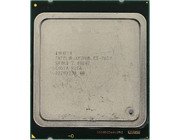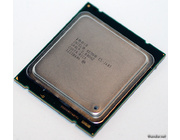Something different than AMD or Intel? Both VIA and Centaur may ring a bell. Centaur dates back to 1995 and designed the IDT WinChip. The WinChip sailed under the name IDT because IDT funded the project. If you look at the CPU-string, you'll see that the WinChip has the vendor name 'CentaurHauls'. At some point in time VIA bought Centaur and that's where the name 'VIA Centaur' connects.
Years later, in 2016 to 2019, they started working on the Centaur CHA CPU. Based on the CNS-core, featuring the latest x86-64 instructions and features, and up to 8 CPU cores. Working samples exist, and Golem.de states that the performance (single-core) in Cinebench R23 is on the same level as the AMD FX-8150.
However, Intel bought the Centaur IP in November 2021, which cancelled the project. The facility located in Austin, Texas, got dismantled, releasing these A0-engineering sample CPUs in the process.
I don't have a motherboard for the CPU so I can't test it. The handwritten remarks on the CPU aren't very hopeful in a working CPU. One might notice it's listed as LGA2011 CPU: physically it is LGA2011 but it's not electrically compatible with Intels' CPU's so never try running these CPU's in motherboards with an Intel chipset. > Read more
When people hear about Core i3 they usually think it's a slow product. You'd better get an i5 or even an i7! Well, that's not always the case. When this CPU was released in 2011 (and still interesting in 2012) it was fairly high clocked and based on the new Sandy Bridge core. It had "just" 2 cores whereas the famous Core i5 2500k and the slightly older Core i7 920 already had 4. Also AMD had quad-core Phenom II X4 counterparts available. Why would the higher clocked i3 be interesting?
It all boils down to your use-case. For Office applications it would fare very well. At the time it was a turning point for games to use more than 2 cores but still some games didn't utilize the extra cores or didn't benefit much. The Core i5 2500k was known to be a long lasting CPU (especially with overclocking) in terms of performance: I would say this Core i3 falls in the same category if you're fine with 2 cores. > Read more
This Xeon is based on the 32nm Sandy Bridge core which makes it a 'second generation' Core processor. Launched in March 2012 and offered a fair deal of performance for a quad-core piece. Sandy Bridge Xeon's are available in 2, 4, 6 and 8 core models. A lot of the Sandy Bridge Xeon's have Hyper-Threading and Turbo enabled but this 1603 has to perform without it.
Higer clocked models where also available, up to 3.6GHz with the quad-core Xeon 1620. > Read more


























